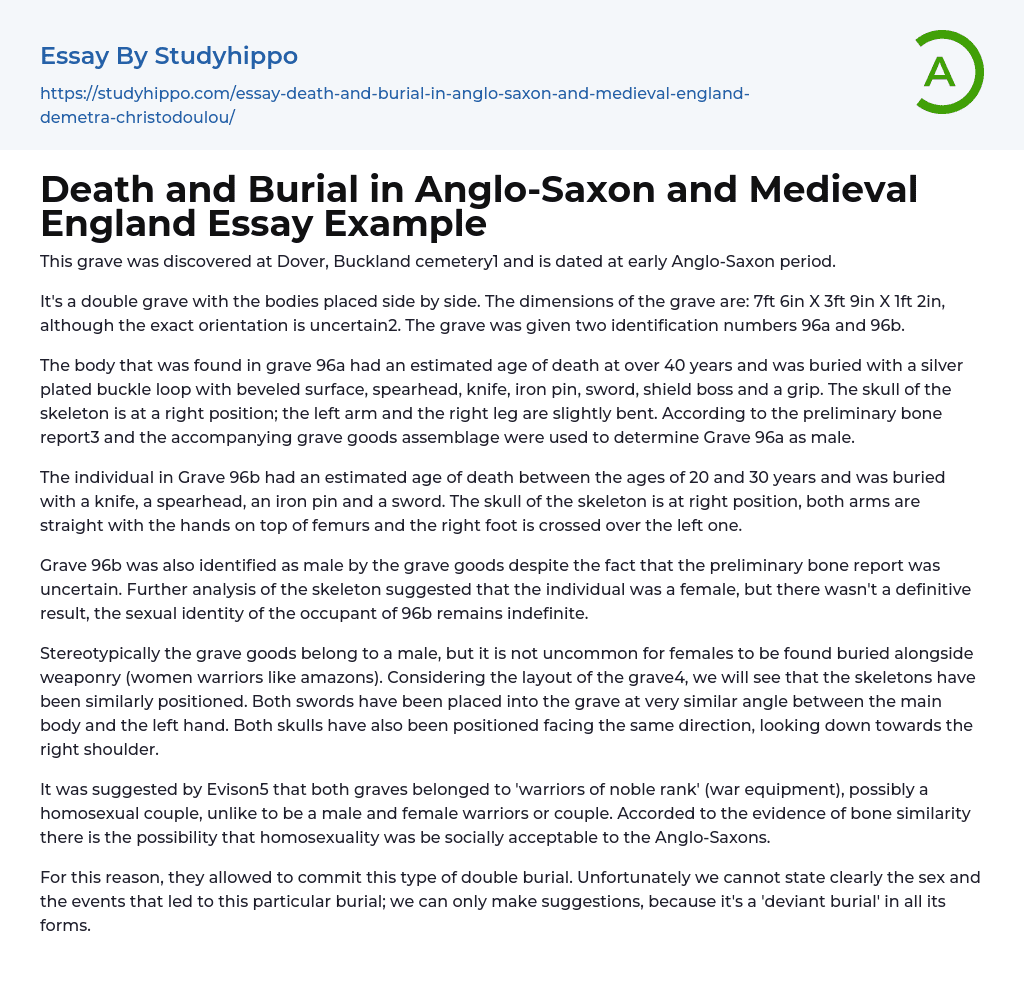

Death and Burial in Anglo-Saxon and Medieval England Essay Example
This grave was found in the early Anglo-Saxon period at Dover's Buckland cemetery1.
It's a double grave with the bodies placed side by side. The dimensions of the grave are: 7ft 6in X 3ft 9in X 1ft 2in, although the exact orientation is uncertain2. The grave was given two identification numbers 96a and 96b.
The body that was found in grave 96a had an estimated age of death at over 40 years and was buried with a silver plated buckle loop with beveled surface, spearhead, knife, iron pin, sword, shield boss and a grip. The skull of the skeleton is at a right position; the left arm and the right leg are slightly bent. According to the preliminary bone report3 and the accompanying grave goods assemblage were used to determine Grave 96a as male.
The individual in Grave 96b had an esti
...mated age of death between the ages of 20 and 30 years and was buried with a knife, a spearhead, an iron pin and a sword. The skull of the skeleton is at right position, both arms are straight with the hands on top of femurs and the right foot is crossed over the left one.
Despite uncertainty in the preliminary bone report, grave 96b was initially identified as male based on the grave goods. However, further skeleton analysis suggested that the individual might be female, though a definitive conclusion could not be reached. As a result, the sexual identity of the occupant of 96b remains unclear.
Although the grave goods stereotypically indicate a male burial, it is not uncommon for females to be found buried with weaponry, similar to women warriors such as amazons. By examining the grave
layout, we can observe that the skeletons have been positioned similarly. Both swords have been placed in the grave at a nearly identical angle relative to the main body and left hand. Additionally, both skulls are facing the same direction, looking down towards the right shoulder.
Evison suggested that both graves may belong to "warriors of noble rank" based on the presence of war equipment, potentially indicating a homosexual couple rather than a heterosexual male-female pair. Considering the similarities in bone structure, it is possible that homosexuality was socially acceptable among the Anglo-Saxons.
Due to this reason, they permitted the execution of this form of dual burial. Regrettably, the gender as well as the circumstances which resulted in this specific burial cannot be definitively determined. We can only propose possibilities, as it is considered an unconventional burial in any manifestation.
- Birmingham essays
- Athens essays
- Belgium essays
- Berlin essays
- British essays
- England essays
- Germany essays
- Great britain essays
- Greece essays
- Ireland essays
- Italy essays
- London essays
- Paris essays
- Pompeii essays
- Rome essays
- Russia essays
- Spain essays
- United Kingdom essays
- Boy essays
- Gay essays
- Gender essays
- Gender Identity essays
- Gender Roles In Society essays
- Gender Stereotypes essays
- Girl essays
- Homosexuality essays
- Human Sexual Behavior essays
- Lgbt essays
- Man essays
- Masculinity essays
- Sexual Orientation essays
- Transgender essays
- Woman essays



